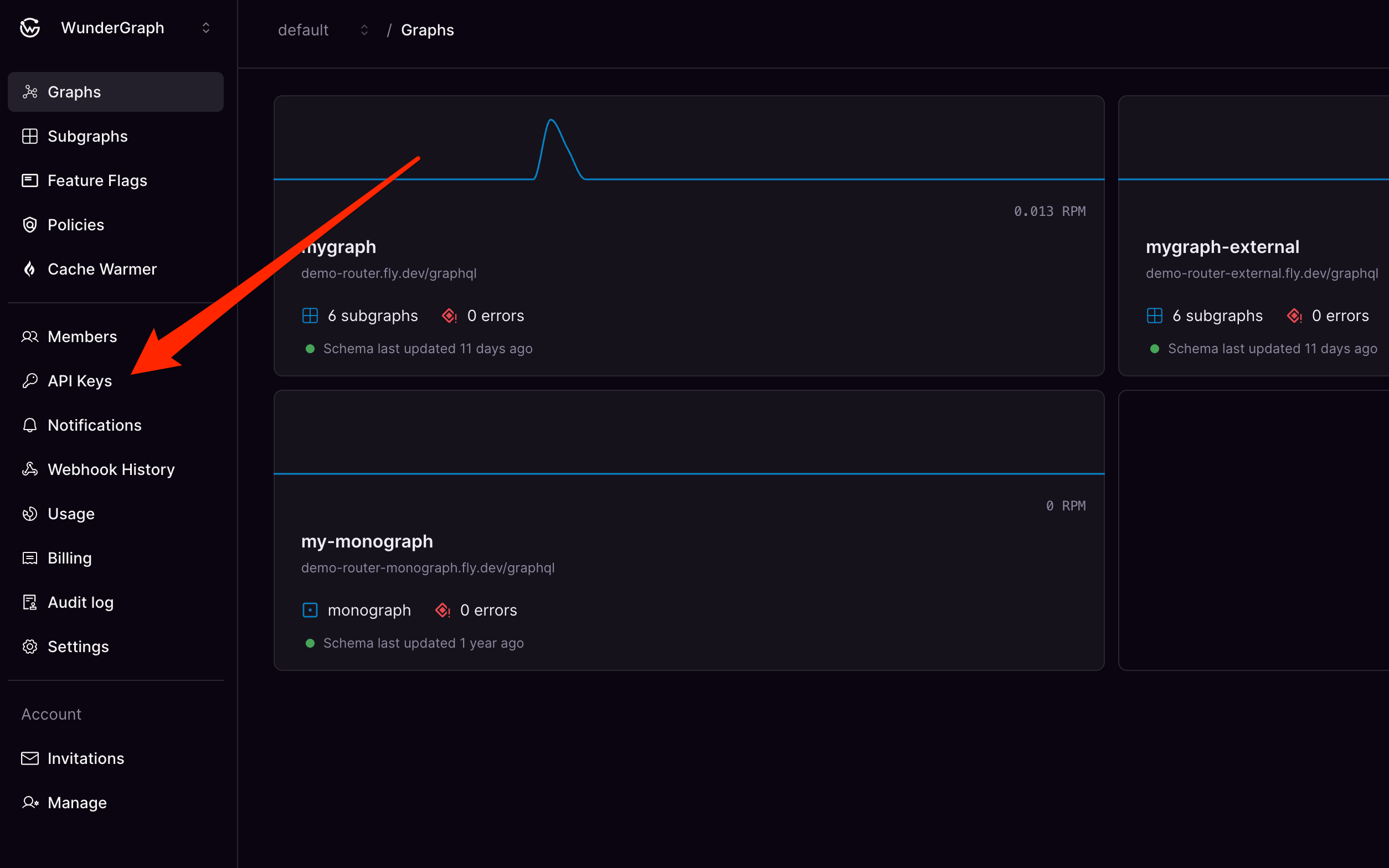Important Note!
The Cosmo MCP Server is currently in beta. Please use it with caution and provide feedback via Discord. Features are subject to change or can be removed without prior notice.Overview
The Cosmo MCP Server allows developers to integrate Cosmo into their modern LLM/AI supported IDEs. The implementation is running fully on the client side using STDIO. As such, the MCP Server requires no additional setup on your machine other than setting up thewgc CLI tool with an API key.
Installation
To install the MCP Server, you’ll need to create an API key and configure your IDE to use it.1. Create a new API key
You can create an API key in Cosmo Studio.
2. Configure your IDE
Add the following configuration to your IDE’s settings. You’ll need to replacecosmo_<redacted> with your actual API key.
Useful Prompts
Here are some example prompts you can use to get started.Setting the Context
Schema Exploration
Load the schema of the Supergraph and summarize the core featuresFind out which subgraphs are part of the Supergraph
Load the SDL of the Supergraph
Explore sub-sections of the Supergraph schema
Dream Query Workflow
Schema Change Proposal Workflow
AI-assisted Router Configuration
Use the Router Config Reference to make changes to the Router configUse the Router Config Reference to enable WebSockets
Documentation Search
Use fulltext search on the documentation to enable specific features in the Router configUse fulltext search on the documentation to understand the steps to publish a Subgraph
All Available Tools (Reference)
The MCP server exposes several tools that an AI model can utilize:Subgraph Management
list_subgraphs: Lists all subgraphs registered in your Cosmo Platform instance.- Use Case: Discovering available subgraphs.
get_subgraphs: Retrieves detailed information for specified subgraphs, including their GraphQL Schema Definition Language (SDL).- Use Case: Inspecting the schema or configuration of specific subgraphs.
introspect_subgraph: Introspects a running subgraph endpoint to retrieve its current GraphQL schema.- Use Case: Fetching the latest schema directly from a subgraph instance, useful for verifying deployments or comparing against registered schemas.
subgraph_verify_schema_changes: Validates proposed changes to a subgraph’s schema. It checks for valid GraphQL SDL, composition compatibility with other subgraphs, and potential breaking changes against client traffic (optional).- Use Case: Safely validating schema modifications before deployment.
Supergraph (Federated Graph) Management
list_supergraphs: Lists all federated graphs (Supergraphs) in your Cosmo Platform instance, optionally filtered by namespace.- Use Case: Discovering available Supergraphs.
fetch_supergraph: Fetches the composed schema (SDL and client schema) and configuration details for a specific Supergraph.- Use Case: Examining the structure and configuration of a Supergraph.
fetch_supergraph_router_config: Retrieves the router configuration (e.g., for WunderGraph Cosmo Router) for a specific Supergraph.- Use Case: Obtaining the necessary configuration to run a compatible router instance.
fetch_supergraph_subgraphs: Fetches a list of all subgraphs that are part of a specific Supergraph, including their individual schemas and routing information.- Use Case: Understanding the composition of a Supergraph and its constituent subgraphs.
Schema Evolution & Query Workflows
schema_change_proposal_workflow: Generates a step-by-step guide or set of instructions for making a specific schema change to a Supergraph safely and effectively.- Use Case: Assisting developers in planning and executing schema changes.
dream_query_workflow: Takes a desired GraphQL query and generates instructions on the necessary schema modifications across relevant subgraphs to support that query within a Supergraph.- Use Case: Streamlining the process of evolving the Supergraph schema to meet new data requirements expressed via GraphQL queries.
verify_query_against_remote_schema: Validates a given GraphQL query against the schema of a deployed Supergraph in your Cosmo Platform instance.- Use Case: Checking if a query is valid before integrating it into an application.
verify_query_against_in_memory_schema: Validates a given GraphQL query against a provided Supergraph schema string (e.g., a locally composed schema).- Use Case: Testing queries against local or proposed schema changes without needing a deployed Supergraph.
Supergraph Changelog
supergraph_changelog: Fetches the changelog for a federated graph / Supergraph.- Use Case: Reviewing the history of schema changes and composition updates for a Supergraph.
Router Configuration Verification
verify_router_config: Verifies a provided Cosmo Router configuration (JSON or YAML) for validity.- Use Case: Ensuring a proposed router configuration is syntactically correct and valid before deployment.
cosmo_router_config_reference: Provides a reference for the Cosmo Router configuration.- Use Case: Understanding the syntax and structure of the Cosmo Router configuration.
Documentation Search
search_docs: Searches the official WunderGraph Cosmo documentation for a given query.- Use Case: Finding relevant documentation pages for specific features, concepts, or troubleshooting steps.